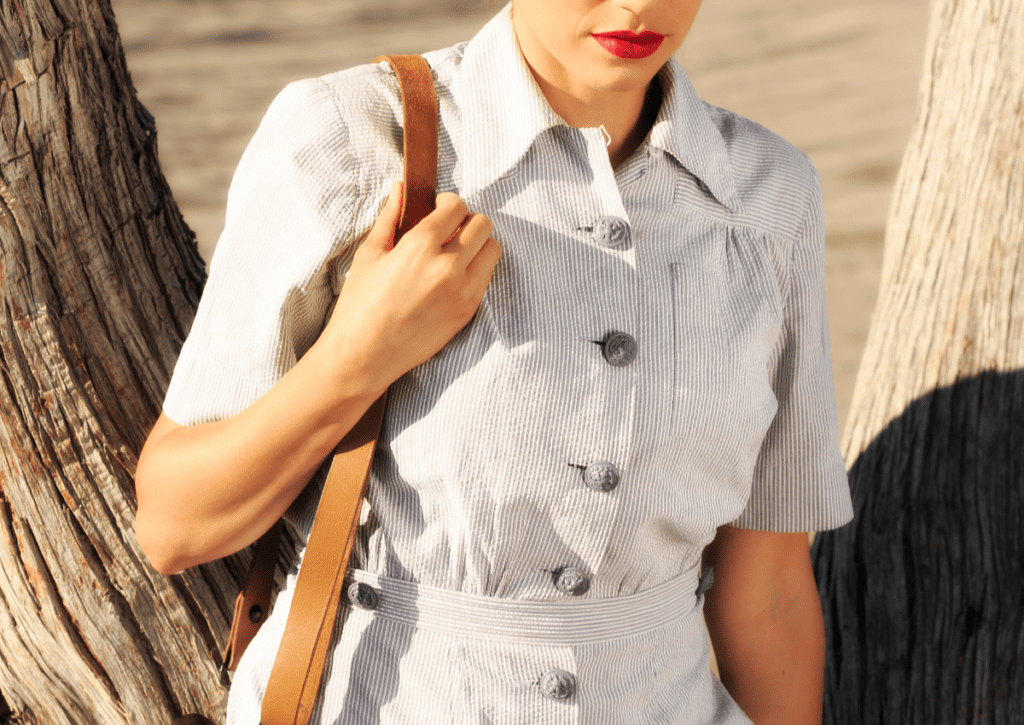Let’s talk about seersucker – a fabric that screams summer vibes! I recently shared some love for tulle, crepe and terry cloth fabric, but now I want to dive into one of my favourite fabrics, seersucker. This fabric has a fascinating history and unique qualities that make it a favourite for all sorts of designs.
In this blog post, I will explain what seersucker is, talk about its origins, explore all the different ways it can be used, and pick up some tips for working with it.

What Is Seersucker Fabric?
Seersucker fabric is a lightweight cotton fabric known for its puckered and smooth stripes that give it a slightly wrinkled appearance. It’s perfect for warm weather and casual outfits because it’s breathable and comfortable.
It is traditionally a lovely light blue and white stripe but can come in many different colours. Some seersucker fabrics are just one colour or striped. Making it super versatile to your style!
The unique puckering effect of seersucker fabric is achieved during the weaving process. Some threads are intentionally woven tighter, while others are left loose. This creates the raised, puckered stripes alternating with the smoother stripes. And get this – the tighter threads contract while the looser threads create the puckered texture, resulting in a fabric that looks great and has some functional benefits.
The puckered texture allows air to circulate more freely between the fabric and your skin, which makes it a perfect choice for summer clothing. That’s why seersucker is so popular for staying cool and comfortable in the warmer months. Pretty neat, huh?
Seersucker fabric is usually made from cotton, but it can also be mixed with other fibres to make it stronger or have unique properties. It’s super lightweight and easy to take care of. Plus, you won’t have to spend hours ironing it because of its wrinkled look!
As an Amazon Associate, I earn from qualifying purchases. Read my full disclosure here.
Where Does The Term Seersucker Originate From?
The term “seersucker” is derived from the Persian words “shir o shekar,” which means “milk and sugar.” This name reflects the fabric’s puckered texture, resembling the ripples on the milk’s surface or the sugar’s uneven texture.

Uses Of Seersucker Fabric
Seersucker is versatile for many textile projects thanks to its casual yet put-together aesthetic. It reminds me of ‘The Hamptons’ or Summer vibes. Here are some uses for seersucker:
- Summer dresses
- Skirts
- Shorts
- Shirts
- Lightweight jackets
- Suits
- Hats
- Bowties
- Scarves
- Tote bags
- Curtains
- Pillows
- Tablecloths
Summer Apparel
Summer clothing should be comfortable, right? Well, seersucker is the perfect choice. It’s light and airy and gives off a relaxed yet polished vibe. So, imagine breezy dresses, skirts, shorts, and light blouses that will make you feel put together and at ease all at once.

Suits and Jackets
If you want to look relaxed and sophisticated, seersucker suits and jackets are a timeless option. The fabric gives your outfit a bit of character and is also perfect for keeping you cool when the weather gets hot.

Children’s Clothing
Have you noticed how cute children’s clothing has become with the addition of fun seersucker stripes? It’s just adorable! From hats to little overalls, seersucker is a classic, charming fabric used in kids’ clothing.

Home Décor
Looking to add a touch of classic style to your living space? Seersucker isn’t just for fashion! Try incorporating it into your home decor with throw pillows, curtains, or tablecloths. These simple additions can give your home a timeless charm that’s sure to impress.
Accessories
From headbands and hair ties to bowties and tote bags, seersucker accessories are a fun way to embrace this fabric’s unique texture.
Sewing Tips For Working With Seersucker Fabric
Just as other fabrics have specific techniques, seersucker also requires a certain approach:
- Cutting – Seersucker tends to fray less than other fabrics due to its puckered nature. Still, using sharp scissors or a rotary cutter is wise to ensure clean edges.
- Use Quality Needles and Thread – Opt for a standard-size needle and quality thread to prevent snagging and puckering.
- Pin or Clip – Use plenty of pins or clips to hold the fabric in place during sewing, especially for curved or complex seams.
- Sewing – Seersucker’s puckered stripes can sometimes make it a bit tricky to sew straight lines. Go for a longer stitch length to prevent puckering, and don’t hesitate to use a walking foot to keep the fabric moving smoothly.
- Pressing – Seersucker benefits from a gentle press. Use a low heat setting and a pressing cloth to keep the fabric’s texture intact.
Caring for Seersucker
To ensure your seersucker creations last, follow these care tips:
- Washing – Seersucker is a low-maintenance fabric that can be machine washed on a gentle cycle with cold water to maintain its texture.
- Drying – Avoid high heat when drying. Opt for air drying or tumble dry on a low setting.
- Storage – Store seersucker items with care. Fold them gently and place them in a cool, dry place.
In Conclusion – Seersucker
Seersucker is a versatile and charming fabric with a unique texture and timeless appeal. It can be used for all sorts of designs, including breezy summer dresses, chic jackets, and elegant home décor. I hope you will try sewing something with seersucker fabric soon, as I’m sure you’ll be pleased with the results!